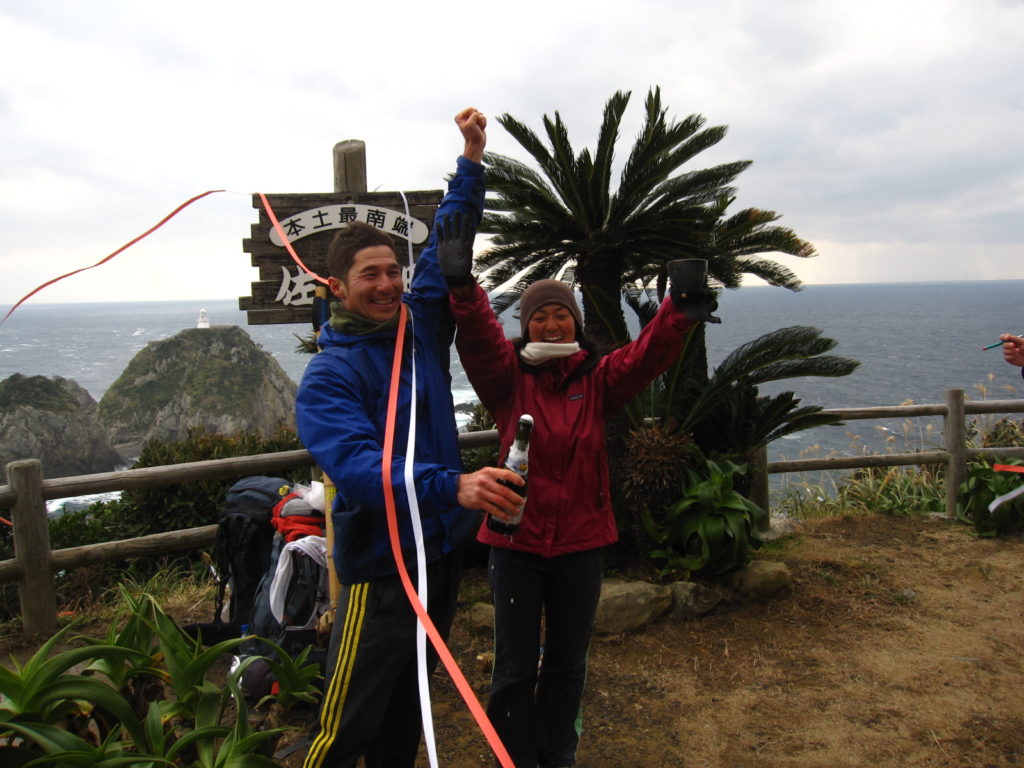The first time I walked on a pair of bamboo stilts with a 20-kg. pack on my back was the day I stood on Japan’s most northerly promontory, Cape Soya, looking down the barrel of a 3,000-km. challenge to walk the length of Japan on stilts with my wife Miki.
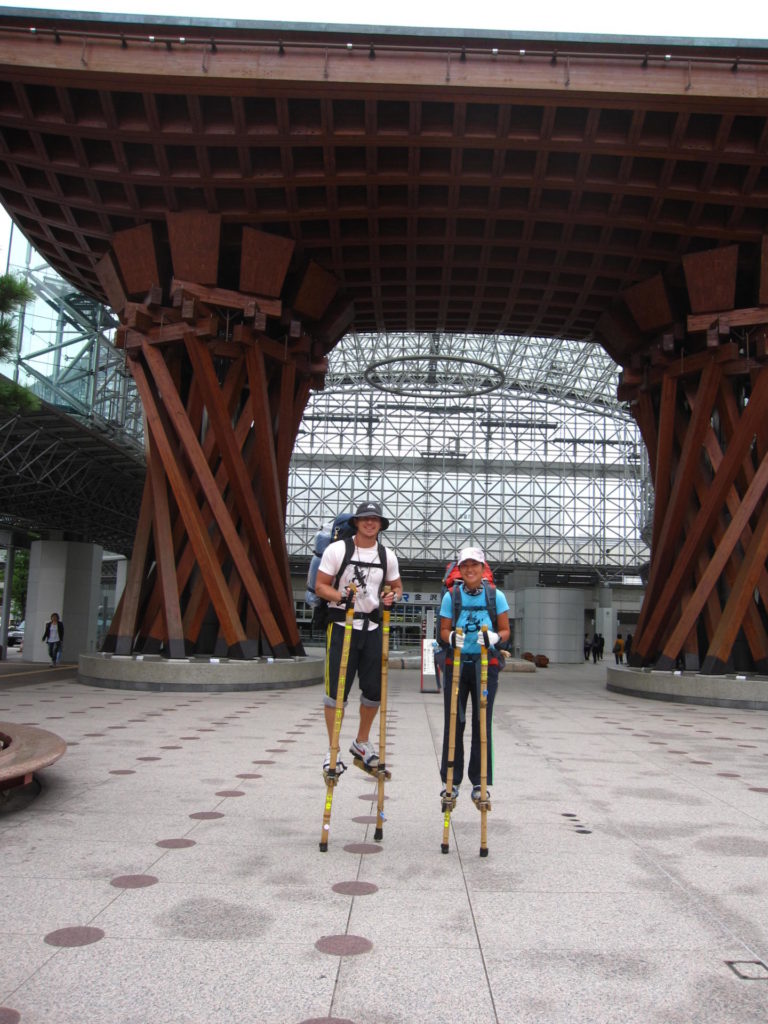
With winds stronger than any we had seen in our local park in Chiba blowing white caps off the Sea of Okhotsk, it would also be the first time we had walked in such challenging conditions. In fact, as we tried stretching our nerves against Soya’s marble monument, we realized everything from this point would be a “first.” Nobody had been crazy enough to attempt this before. As we began our journey and the rain started to fall horizontally, we began to understand why, one step at a time.
When we first met with Outdoor Japan in June 2009, we were filled with a bravado that comes from planning a crazy adventure in comfortable surroundings. It started with a simple goal to teach some disbelieving students a lesson. After a classroom lesson about the challenges facing orangutans in Borneo and Sumatra, the problems were “impossible to solve,” they said. The issue of deforestation was “too big,” and if the world couldn’t solve these problems, how then could they?
“Nothing is impossible” sounds good as a slogan, but it’s different when you are trying to convince a class of concerned students to believe it when you are not sure if it is true yourself. So, our idea was brilliantly simple; find something everyone says cannot be done, then do it and come back and say, “See, nothing is impossible!” Miki came up with the idea to walk the length of Japan on takeuma, or stilts. It seemed perfect. And so the “Pongo Hogo Hogo Challenge” was born.
We bought two one-way tickets to Hokkaido where we would start the challenge at Cape Soya on a pair of freshly cut bamboo poles. Our goal was to walk south until we reached Cape Sata in Kyushu.
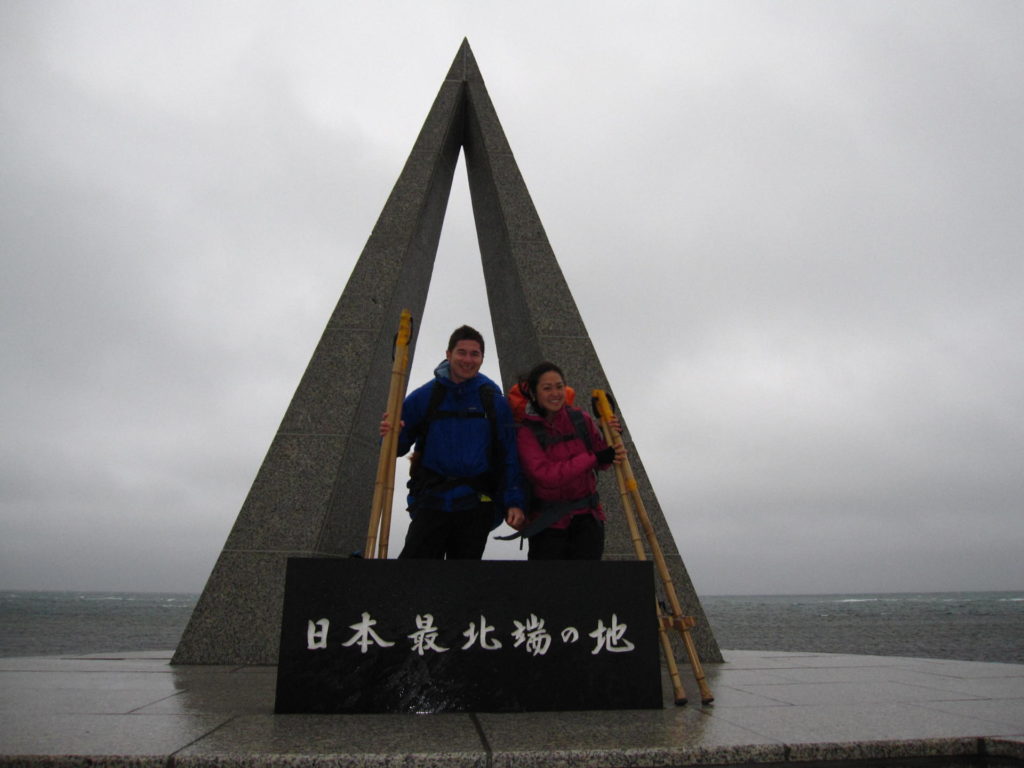
It took almost all of that first month for us to come to grips with our stilting reality. Our days were long, our hands and feet were sore and our bags seemed always to get heavier over the course of our 15-to-20-km. days. But when we opened our eyes, the beauty that surrounded us captivated us.
The plains of Hokkaido’s Sarobetsu National Park were filled with migratory birds and bounding deer who bleated their greetings as we walked slowly by. Wild flowers lined our way and, with the conical silhouette of Rishiri Island looking over us to the west, our aches became more bearable and the distances seemed more doable. With wide roads, few cars and friendly locals, it was the perfect place for us to ease into the demands of our challenge.
The first of August signaled our arrival in Honshu and the beginning of summer. Whereas Hokkaido had been cooled by an unusually rainy July, the roads in Aomori, Akita and Yamagata were all sweltering under clear blue skies and the exhaust fumes of holidaying cars all eager to get to the same beaches we walked beside.
We took every opportunity to cool down in the clear waters of the Japan Sea, wondering why most of the people were more content to sit next to their barbecues than paddle around in the rock pools that dotted the rocky coastline. Tohoku was a part of Japan we had never seen, but the more we passed rows of squid hanging to dry, or cascading rice paddies overlooking the ocean, it was one we came to love.
 With such views to keep us occupied, we found the distances disappeared more easily. Our bodies, however, were ending each day with the same pains they had felt back in Hokkaido. Toenails were going black, blisters were forming on blisters, and muscles just wouldn’t loosen up. It was to be a part of the challenge we would have to endure right to the very end in Kagoshima, but one we came to realize was all part of walking the length of Japan on stilts.
With such views to keep us occupied, we found the distances disappeared more easily. Our bodies, however, were ending each day with the same pains they had felt back in Hokkaido. Toenails were going black, blisters were forming on blisters, and muscles just wouldn’t loosen up. It was to be a part of the challenge we would have to endure right to the very end in Kagoshima, but one we came to realize was all part of walking the length of Japan on stilts.
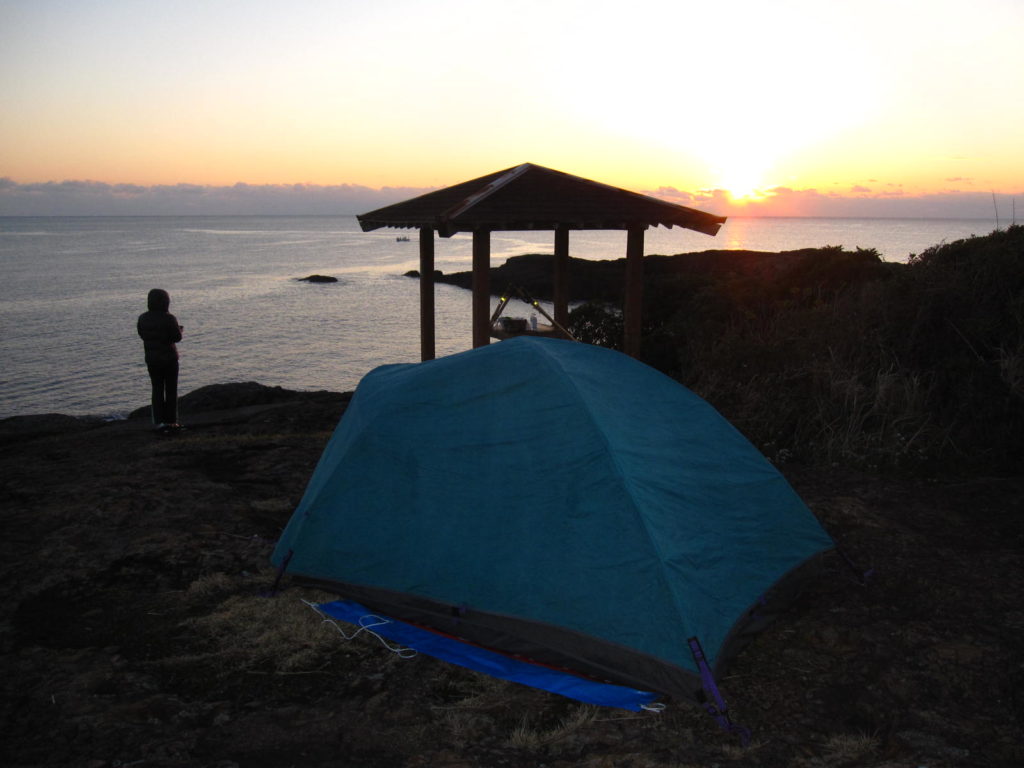
The further south we wandered, the bigger the towns got. Bigger towns meant more attention as we walked past bewildered faces peering from car windows.
We became quite good at reading lips with comments ranging from ‘”sugoi” or “Wow, look at that!” to “Baka da ne” or “Look at those crazy buggers!” Sometimes people said nothing, as they drove, mouths agape toward the very edge of disaster before recovering their composure and, fortunately for them and sometimes us, their direction.
Almost every person who passed, however, mouthed the word “takeuma” or stilts, as if seeing them brought back some recollection from their youth. Walking down the length of Japan on something not traditionally Japanese seemed wrong and, as we watched lips after lips mouthing the same familiar word, we silently congratulated the decision to have chosen something so central to everyone’s past.
The takeuma themselves were holding together much better than we had expected, or anyone else for that matter and, as we passed through rolling surf in Niigata, golden fields of rice in Toyama and our halfway point at Kanazawa’s historical heart, we bid a fond farewell to the Japan Sea and turned left for the metropolises that lay ahead along Japan’s Pacific coast.
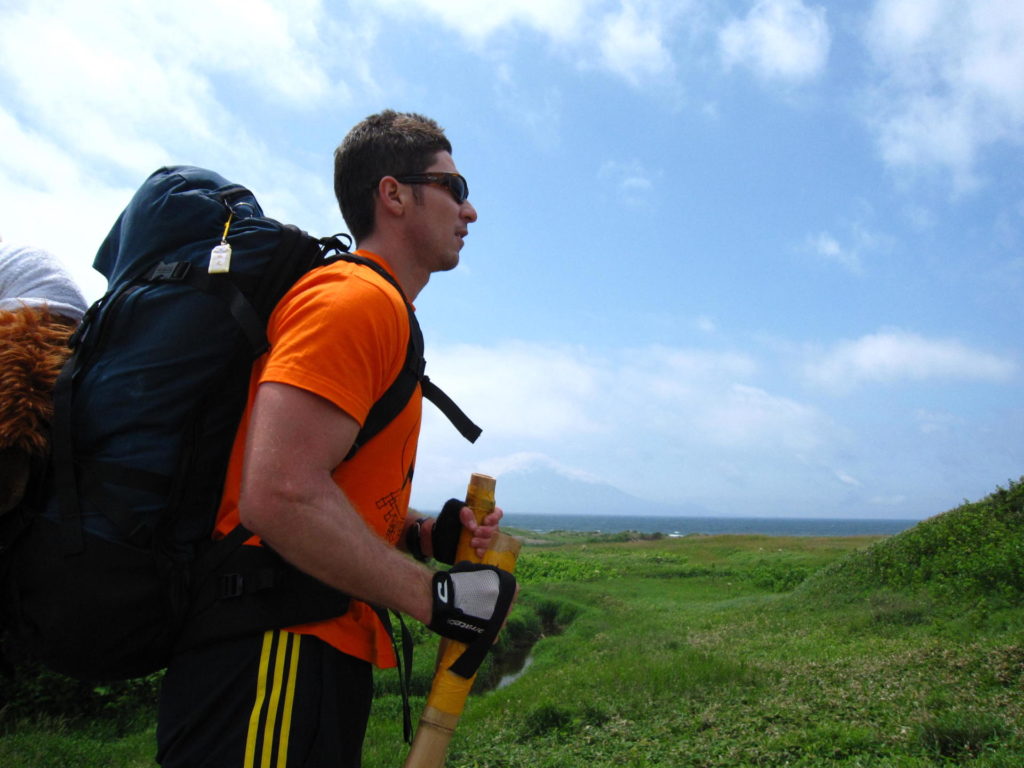
It was this reintroduction to the fast lane that actually put the brakes on our momentum for the first time. Our daily routine of walking, cooking and then making camp proved much more difficult in the concrete jungles that surrounded Kyoto, Osaka and Kobe. The cheery shouts of encouragement we had enjoyed along the Japan Sea were replaced by the indifference of people caught up in the rush of city life.
It was a motivation killer we hadn’t prepared for and, as our days dragged endlessly among the smokestacks of factory filled cities, we constantly fought, not only with each other, but with the gnawing feeling the challenge’s end lay somewhere among this hazy landscape
Had it not been for the sudden emergence of one very simple and anticipated event in Japan, our challenge may have ended there. As we struggled through Kobe, and into Himeji with its beautifully preserved castle, we were confronted by an assortment of colors that seemed to bounce off the hills surrounding us.
Autumn had arrived, the trees were celebrating in glorious style and the simple sight of a Japanese kouyou in the soft light of morning and afternoon did wonders for our legs and our motivation.
Each day, despite the traffic along our congested course, we floated along past Okayama’s Korakuen Garden, Hiroshima’s temple-filled town of Onomichi and on to Shikoku over the spectacular cycling/walking friendly Shimanami Kaido or highway over the sea.
Mikan (mandarin oranges) hung from trees like Christmas decorations along much of our route in Ehime and, for the first time since Hokkaido, we met other travelers—ohenro-san—each on their own spiritual pilgrimage to walk Shikoku’s 88 temples.
As November rolled into December, we crossed into Kyushu by ferry and were faced by our last frightful test before our goal in Kagoshima. Mountains as tall as the horizon loomed in front of us. By walking along the coastal roads, we had somehow managed to avoid the worst of them up until now, but there seemed no way of getting around these.
With winter now here, the colder temperatures were a new challenge. Numbed by frigid mornings, our hands could no longer feel the stilts and our feet struggled to find the footrests with each step. Walking became a test of concentration, but with our minds occupied with the task of simply walking, the mountains that had seemed so frightening were disappearing in the constant fight to simply stay upright.
After a short break for Christmas, and buoyed by the warmth of Kyushu’s people, the days passed quickly, and the New Year brought with it our first view of Kagoshima Bay and the southern tip of Japan. With Sakurajima smoldering to our right, and Mt. Kaimon standing protectively across from Cape Sata, we felt our first pang of sadness for the end of a trip that six months earlier had seemed so unlikely.
Coming into Cape Sata on our 189th and last day, the winds that had marred the start had returned to see us to our goal. Worse than any typhoon wind we had seen, they blew against every step as if to say, “It’s yours if you can get there.” But there was no doubt in our minds. Together we had learned anything really is possible, if you face up to it one small step at a time.

Support for the Orangutan no Mori Hogo Saisei Project
During our trip, we raised almost $11,000 for the orangutan and their forest homes, almost all of which has come from the pockets of people along the way. All funds will be used by Borneo Orangutan Survival Foundation’s (BOS) “Orangutan no Mori Hogo Saisei Project” which aims to purchase parcels of land in Borneo for the reintroduction of rehabilitated orangutans into the wild. Donations can still be made through our site or the BOS Japan site. Every little bit helps.
Save Pongo: http://savepongo.blogspot.com
BOS Japan: www.bos-japan.jp
